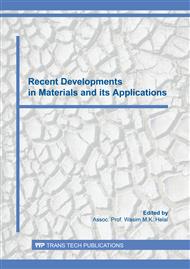[1]
BRONZ, A., et al. Structure and strength cast high aluminum and manganese of iron alloys with a high carbon content. In: Machines, Technolgies, Materials 9o International Congress, Varna, Bulgaria. (2012). pp.36-37.
Google Scholar
[2]
Kim, Young G., Jong M. Han, and Jong S. Lee. Composition and temperature dependence of tensile properties of austenitic Fe-Mn-Al-C alloys., Materials Science and Engineering: A 114 (1989): 51-59.
DOI: 10.1016/0921-5093(89)90844-7
Google Scholar
[3]
Shih, S. T., C. Y. Tai, and T. P. Perng. Corrosion behavior of two-phase Fe-Mn-Al alloys in 3.5% NaCl solution., Corrosion 49.2 (1993): 130-134.
DOI: 10.5006/1.3299207
Google Scholar
[4]
Saxena, Vikas Kumar, et al. Fatigue and fracture behavior of a nickel-chromium free austenitic steel., International journal of pressure vessels and piping 60.2 (1994): 151-157.
DOI: 10.1016/0308-0161(94)90021-3
Google Scholar
[5]
Zhu, X. M., and Y. S. Zhang. Investigation of the electrochemical corrosion behavior and passive film for Fe-Mn, Fe-Mn-Al, and Fe-Mn-Al-Cr alloys in aqueous solutions., Corrosion 54.1 (1998): 3-12.
DOI: 10.5006/1.3284826
Google Scholar
[6]
Morris Morris, D. G., M. A. Muñoz-Morris, and L. M. Requejo. New iron–aluminium alloy with thermally stable coherent intermetallic nanoprecipitates for enhanced high-temperature creep strength., Acta materialia 54.9 (2006): 2335-2341.
DOI: 10.1016/j.actamat.2006.01.008
Google Scholar
[7]
Frommeyer, Georg, and Udo Brüx. Microstructures and Mechanical Properties of High-Strength Fe-Mn-Al-C Light-Weight TRIPLEX Steels., Steel Research International 77.9-10 (2006): 627-633.
DOI: 10.1002/srin.200606440
Google Scholar
[8]
James, P.J. Precipitation of The Carbide Fe-Mn-3Al-C in an iron-aluminium alloy., J Iron Steel Inst 207.1 (1969): 54-57.
Google Scholar
[9]
Lai, H. J., and C. M. Wan. The study of work hardening in Fe-Mn-Al-C alloys., Journal of materials science 24.7 (1989): 2449-2453.
DOI: 10.1007/bf01174510
Google Scholar
[10]
Chen, F. C., et al. Effect of aluminium on TRIP Fe-Mn-Al alloy steels at room temperature., Materials Science and Engineering: A 160.2 (1993): 261-270.
DOI: 10.1016/0921-5093(93)90455-n
Google Scholar
[11]
Sato, Kazunori, Kazuhiro Tagawa, and Yasunobu Inoue. Modulated structure and magnetic properties of age-hardenable Fe-Mn-Al-C alloys., Metallurgical Transactions A 21.1 (1990): 5-11.
DOI: 10.1007/bf02656419
Google Scholar
[12]
Hwang, C. N., C. Y. Chao, and T. F. Liu. Grain boundary precipitation in an Fe-8.0 Al-31.5 Mn-1.05 C alloy., Scripta metallurgica et materialia 28.2 (1993): 263-268.
DOI: 10.1016/0956-716x(93)90574-c
Google Scholar
[13]
Rahnama, Alireza, Hiren Kotadia, and Seetharaman Sridhar. Effect of Ni alloying on the microstructural evolution and mechanical properties of two duplex light-weight steels during different annealing temperatures: Experiment and phase-field simulation., Acta Materialia 132 (2017): 627-643.
DOI: 10.1016/j.actamat.2017.03.043
Google Scholar
[14]
Mazancová, Eva, Ivan Ružiak, and Ivo Schindler. Influence of rolling conditions and aging process on mechanical properties of high manganese steels., Archives of Civil and Mechanical Engineering 12.2 (2012): 142-147.
DOI: 10.1016/j.acme.2012.04.009
Google Scholar
[15]
MAZANCOVÁ, Eva, et al. Influence of aging process on strengthening of three Triplex steel types., Brno, Czech Republic, EU, 2012, 23. - 25. 5.
Google Scholar
[16]
Li, Changsheng, et al. The Annealing Twins of Fe-20Mn-4Al-0.3 C Austenitic Steels during Symmetric and Asymmetric Hot Rolling., Metals 8.11 (2018): 882.
DOI: 10.3390/met8110882
Google Scholar
[17]
Frommeyer, G. Microstructure and mechanical properties of high-strength and supraductile manganese-aluminium lightweight TRIPLEX steels., 3rd Discussion Meeting on the Development of Innovative Iron Aluminium Alloys. (2006).
Google Scholar
[18]
Yoo, Je Doo, Si Woo Hwang, and Kyung-Tae Park. Factors influencing the tensile behavior of a Fe–28Mn–9Al–0.8 C steel., Materials Science and Engineering: A 508.1-2 (2009): 234-240.
DOI: 10.1016/j.msea.2008.12.055
Google Scholar
[19]
Herrmann, J., G. Inden, and G. Sauthoff. Deformation behaviour of iron-rich iron-aluminum alloys at low temperatures., Acta Materialia 51.10 (2003): 2847-2857.
DOI: 10.1016/s1359-6454(03)00089-2
Google Scholar
[20]
Takasugi, T., S. Hanada, and O. Izumi. Slip modes in B2-type intermetallic alloys., Materials Transactions, JIM 31.6 (1990): 435-442.
DOI: 10.2320/matertrans1989.31.435
Google Scholar
[21]
Rahnama, Alireza, Stephen Spooner, and Seetharaman Sridhar. Control of intermetallic nano-particles through annealing in duplex low density steel., Materials Letters 189 (2017): 13-16.
DOI: 10.1016/j.matlet.2016.11.020
Google Scholar


